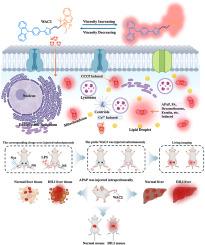TICT-activated viscosity sensitive mitochondrial probes for imaging and early diagnosis of drug-induced liver injury
IF 6
2区 化学
Q1 CHEMISTRY, ANALYTICAL
引用次数: 0
Abstract
Background
Drug-induced liver injury (DILI) poses a significant clinical challenge, with mitochondrial dysfunction and elevated microviscosity emerging as key pathological features.Results
We reported the rational design and synthesis of a series of viscosity-responsive fluorescent probes WACn (n = 2, 4, 6, 8, 10), based on a D-π-A architecture utilizing the twisted intramolecular charge transfer (TICT) mechanism. These probes integrated a carbazole-thiophene electron-donating unit and a benzoindolium acceptor modified with varying alkyl chains to tune intramolecular rotation and viscosity responsiveness. Study results revealed that probes WACn (n = 2, 4, 6, 8, 10) exhibited strong viscosity-dependent fluorescence enhancement, robust photostability, low cytotoxicity, and excellent mitochondrial targeting specificity. Notably, probe WAC2 enabled mitochondrial imaging at an ultralow concentration (30 nM) and functioned independently of membrane potential. Besides, WAC2 successfully reported viscosity changes under multiple drug stimulations (PA, H2O2, Cu2+, dexamethasone, erastin, etc.) as well as antifungal drug (nystatin-induced) and inflammation (lipopolysaccharide-induced), both in cells or in vivo. Meanwhile, WAC2 enabled monitor changes in viscosity during APAP-induced drug-induced injury in normal hepatocytes as well as hepatoma cells. Most importantly, it enabled the multi-level visualization of DILI progression in BALB/c mice, including tissue, organ and living levels.Significance
Collectively, probe WAC2 provides a powerful platform for real-time, in situ monitoring of mitochondrial viscosity and offers valuable insights for early diagnosis and mechanistic investigation of DILI.

tict激活黏度敏感线粒体探针在药物性肝损伤成像及早期诊断中的应用
药物性肝损伤(DILI)是一项重大的临床挑战,线粒体功能障碍和微粘度升高是其主要病理特征。结果利用分子内扭曲电荷转移(TICT)机理,设计合成了一系列基于D-π-A结构的粘度响应荧光探针WACn (n = 2,4,6,8,10)。这些探针集成了一个咔唑-噻吩电子给体单元和一个用不同烷基链修饰的苯并吲哚受体,以调节分子内旋转和粘度响应性。研究结果表明,探针WACn (n = 2,4,6,8,10)具有很强的黏度依赖性荧光增强,强大的光稳定性,低细胞毒性和出色的线粒体靶向特异性。值得注意的是,探针WAC2可以在超低浓度(30 nM)下实现线粒体成像,并且独立于膜电位发挥作用。此外,WAC2在多种药物刺激(PA、H2O2、Cu2+、地塞米松、erastin等)以及抗真菌药物(制虫抑素诱导)和炎症(脂多糖诱导)下,在细胞内或体内均成功报道了黏度的变化。同时,WAC2能够监测apap诱导的正常肝细胞和肝癌细胞药物损伤过程中黏度的变化。最重要的是,它实现了BALB/c小鼠DILI进展的多层次可视化,包括组织、器官和生活水平。总之,探针WAC2为实时、原位监测线粒体粘度提供了一个强大的平台,为DILI的早期诊断和机制研究提供了有价值的见解。
本文章由计算机程序翻译,如有差异,请以英文原文为准。
求助全文
约1分钟内获得全文
求助全文
来源期刊

Analytica Chimica Acta
化学-分析化学
CiteScore
10.40
自引率
6.50%
发文量
1081
审稿时长
38 days
期刊介绍:
Analytica Chimica Acta has an open access mirror journal Analytica Chimica Acta: X, sharing the same aims and scope, editorial team, submission system and rigorous peer review.
Analytica Chimica Acta provides a forum for the rapid publication of original research, and critical, comprehensive reviews dealing with all aspects of fundamental and applied modern analytical chemistry. The journal welcomes the submission of research papers which report studies concerning the development of new and significant analytical methodologies. In determining the suitability of submitted articles for publication, particular scrutiny will be placed on the degree of novelty and impact of the research and the extent to which it adds to the existing body of knowledge in analytical chemistry.
 求助内容:
求助内容: 应助结果提醒方式:
应助结果提醒方式:


